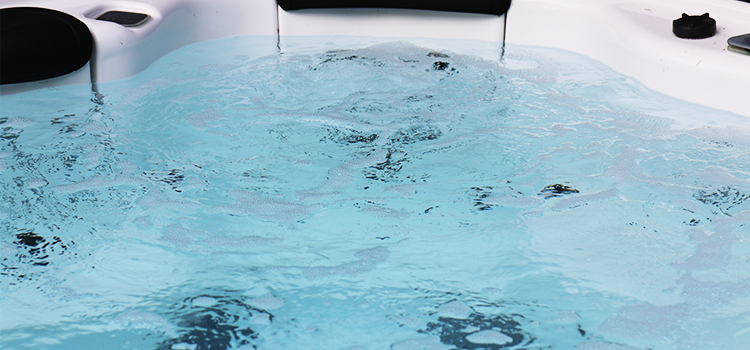How to look after your hot tub water quality
Hot Tub Water treatment
Hot tub water quality, water hygiene and water hygiene management are a crucial part of routine hot tub maintenance.
Why is this? A hot tub is one of the most wonderful, therapeutic and lifestyle-enhancing home improvements that you can invest in. However, it is important to ensure the water in your hot tub is clear, clean and hygienically safe, as some potentially harmful micro-organisms could otherwise cause problems if left unchecked.
Therefore it is vital that your water is treated to BISHTA Standards. (BISHTA is The British and Irish Spa and Hot Tub Association). The good news is that this is neither expensive nor time-consuming. To learn more, read on to discover the fact about hot tub water care.
There is a wide choice of water treatment products on the market which are safe, easy to use and reliable. The most common types of water treatment products are sanitisers (disinfectants), oxidizers, minerals and pH balancers.
Darlly offer the adjustable SaniStream inline dosing pod system to dispense your choice of water treatment directly into the water flow.

Hot Tub Sanitisers
BISHTA recommends the continuous use of a residual sanitiser to help maintain hot tub water quality. A residual sanitiser is a substance which kills potentially harmful micro-organisms rapidly and leaves a residual in the water which can be measured. A residual sanitiser MUST be used, irrespective of any other backup equipment or substance (i.e. an ozone generator or mineral cartridge) which may be used.
The Health Protection Agencies (such as Health Protection England) and the Health and Safety Executive (HSE) recognise and consider the use of the following oxidising biocides essential: chlorine, bromine or PHMB (Biguanide) – see HSE/HPA Management of Spa Pools, Controlling the Risk of Infection.
Chlorine
Chlorine is a fast and effective sanitiser, and its biocidal properties are well-established and proven.
Darlly SaniStream® Direct Line Filtration system is a technology which combines the world’s finest hot tub filters with a safe, convenient and effective sanitiser dispenser to give an integrated spa water treatment system.
SaniStream® is suitable for both domestic hot tubs, helping to maintain water quality and also allowing compliance with Section 76 of HSG282 regulations for hot tubs installed in holiday let units.
Bromine
Bromine (usually BCDMH) is also available. It is popular among hot tub owners as it does not give off the ‘swimming pool odour’ some associate with Chlorine, and it’s also very effective at higher temperatures.
Bromine is available in tablet form which is suitable for the Darlly SaniStream inline dispenser.
Oxidation
Oxidation is carried out utilising a “non-chlorine shock”, which can break down some organic matter and help prevent/break down Combined Chlorine. However, mono-persulphate is not a sanitiser (or disinfectant). Non-chlorine shock can be used, for example, before a party and again afterwards; bathing does not have to cease following the application.
Super-chlorination using a quick-dissolving calcium hypochlorite will both oxidise to help break down Combined Chlorine and will quickly kill bacteria. Shock dosing a hot tub at 20 ppm for 2.5 hours is recommended upon initial fill of a hot tub and monthly thereafter. The residual chlorine needs to fall back to below 10 ppm before bathers can use the hot tub. A weekly shock dose at 10ppm with fast-dissolving calcium hypochlorite granules is a good routine which can also be applied after a party when more people than usual have used the hot tub.
pH Balancers
For your sanitiser to work most effectively and for the comfort of bathers and protection of the hot tub’s equipment, the water’s pH must be controlled. pH is, in the most basic terms, the balance between acid and alkaline substances in the water. If water is too acidic, then the water will be corrosive, and if it’s too alkaline, then there is more likelihood for damaging scale to form. pH balancers are water treatment products which allow you to easily and safely control. pH balancers need to be added gradually to achieve the correct levels.
Acids or pH reducers: Used to lower a high pH.
Alkalis or pH increases: Used to raise a low pH.
T.A. increases: Used to increase the Total Alkalinity. Total Alkalinity is a measure of the total amount of alkaline substances in the water. If it’s too high, it will make an incorrect pH difficult to adjust, and if it’s too low, then small additions of either pH reducers or pH increasers will cause the pH to swing one way and then the other rapidly. So the correct TA acts as a ‘buffer’ against this and allows you to control the pH easily, quickly and effectively.
Testing
In order to know whether you are treating water correctly and, therefore, whether it is safe and hygienic to use, it is vitally important to test your hot tub water quality daily before use to find out what the pH and sanitiser levels in your water are. You will then need to make any adjustments required, as highlighted by your test results.
There are a number of inexpensive test kits on the market which are quick, safe and reliable to use. Testing just takes a few seconds, whether by the tablet type test kit – where tablets which change colour according to readings are dropped in to a sample of the hot tub’s water; or by test strips, small strips with impregnated pads which change colour when dipped into your hot tub’s water. NB: Both test strips and test tablets have use-by dates. It is important that you only use strips and tablets that are in-date.
If you have any comments or a suggestion of a topic that you would like us to cover, please don’t hesitate to get in touch and we will see what we can do for you.
Happy Hot tubbing!
The Darlly Team
